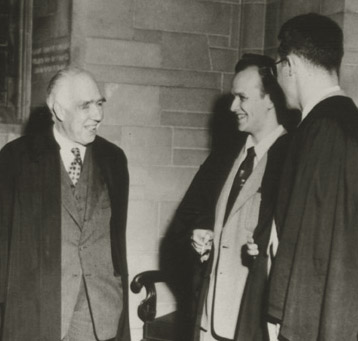Science Fiction and Fact

1927
The Copenhagen Interpretation
Schrödinger's equation describes the subatomic world, but the
world that we know seems to follow the rules of classical—not
quantum—mechanics. How can this be? Danish physicist Niels
Bohr (shown here in polka-dotted tie, years later) provides a
possible answer in a 1927 lecture on his theory of
"complimentarity," which forms the basis for what will later be
known as the Copenhagen Interpretation. By this time, researchers
are aware of another surprising result of the double-slit experiment
(when conducted with electrons). If, in the course of the
experiment, the researchers try to track the electron as it passes
through the slits, the electron starts acting like a particle, not a
wave—the interference pattern on the screen disappears. The
Copenhagen Interpretation holds that the very act of measuring (or
observing) the electron's position causes something called "waveform
collapse." In other words, observed matter acts like a particle.